By John Hagan
Sonar images, captured in early September 2014, by a team of Canadian marine surveyors, have helped shed light on a longstanding mystery involving Banbridge explorer, Captain Francis Crozier. Thanks to this new technology, the final resting place of one of the two ships (Erebus or Terror), on Crozier’s ill-fated North West Passage exploration of 1845, has been found. John Hagan describes the background to the Royal Navy’s greatest ever polar exploration disaster and Crozier’s role in it.
Far from this spot
In some unknown but not unhonoured resting place lie all that was mortal of
Francis Rawdon Moira Crozier Captn R.N.
So reads the commemorative marble plaque in Holy Trinity Parish Church, Banbridge (Co Down). In the square outside, his monument stands proudly opposite the house in which he was born. Snapping around his feet are the polar bears reputed to have taken his life. His was a remarkable existence, full of adventure, exploration, bravery and – disappointment. While Irishmen have always been in the vanguard of Polar exploration – Shackleton, Crean, McClure, McClintock and Kellett – Crozier’s feats are arguably the most remarkable, involving five expeditions to the Arctic and two voyages to the Antarctic. He was truly an extraordinary cold water warrior.
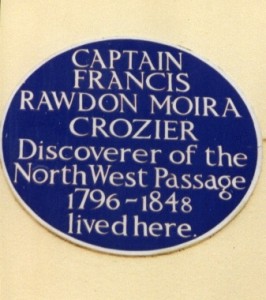
Plaque on Crozier’s former house in Banbridge
Born in 1796, Francis, the fifth son of Banbridge Attorney, George Crozier, joined the Royal Navy in 1810, when he was just fourteen. During the next thirty years he served the Senior Service on frigates, ships-of-the line, cutters and gun brigs, in the Atlantic, Pacific and Indian Oceans, while working his way from cabin boy to captain.
It was in 1819 that he had his first taste of Polar exploration, volunteering to join an expedition led by the legendary Commander W E Parry in search of the North-west Passage. It was the beginning of a passion which would eventually see him spend some ten winters clenched in the mandibles of Polar ice.
Smitten by the discovery bug, three more Arctic voyages with Parry followed in 1821, 1823 and 1828, the latter a failed attempt to traverse the ice to the North Pole. Crozier was not part of the overland foray, but remained on board HMS Hecla to make astronomical and magnetic observations. He returned to Banbridge on half-pay before teaming up with his former messmate James Clark Ross in 1835, on a dangerous expedition to rescue missing whalers caught in the winter ice of Davis Strait in the Antarctic. But it was his second voyage south, from 1839 until 1843, which would so profoundly impact on his future.
Again under the leadership of Ross, Crozier left England in 1839 in HMS Terror for the purposes of magnetic research and geographical discovery in Antarctica and the Southern Ocean. Headquarters for the expedition was Hobart Town, capital of Van Diemen’s Land (now Tasmania). While the colony comprised of about 6,000 ‘free settlers’, it was also ‘home’ to some 15,000 convicts, including thousands of Irish, sentenced to transportation for often trifling misdemeanours.
It was in Hobart that Crozier made the acquaintance of the Colony’s Governor, and his future North West Passage commander, Sir John Franklin. Also a resident in Government House was Franklin’s niece, Sophy Cracroft, described as “a young lady of beauty and fortune”. Although many years her senior, Crozier fell deeply in love with Sophy and proposed to her in 1841. But Sophy, being something of a snob, regarded Crozier as “a horrid radical and an indifferent speller”, not to mention being ‘poor Irish’, so his advances were quickly rebuffed. When they met again in London in 1844, on the eve of what was to be his last voyage, Crozier made a second offer of marriage and was again refused.
During the early part of the nineteenth century, Sir John Barrow, England’s Secretary of the Admiralty, had dispatched eight Royal Navy expeditions in an effort to discover the North West Passage and a lucrative trade route to the Orient. Under pressure from other European seafaring nations and commercial interests in England, a further attempt was launched in 1845.
This was to be the largest, best-equipped Polar expedition ever mounted. The two ships chosen, HMS Erebus, and Crozier’s former Southern Ocean vessel HMS Terror, were the most technologically advanced vessels on the planet. Their bows and bottoms were specially reinforced, internal heating and insulation systems were installed, and each was fitted with sophisticated retractable screw propellers powered by locomotive steam engines. The vessels were also equipped with their own desalinators, and lavishly provisioned thanks to a recent innovation – canned food. Staffed by 129 hand picked sailors, this was the Apollo mission of its day. Yet, it vanished without trace – the worst disaster in the history of polar exploration.
Leadership of the mission was offered to Crozier’s erstwhile host in Van Diemen’s Land, Sir John Franklin. While Franklin was a Polar explorer of some renown, he was almost sixty years old, had not been to sea for thirteen years, and had not set foot in the Arctic in seventeen years. There is little doubt that, given his relative youth, knowledge and experience, Crozier should have been offered the position, but, was passed over for the English knight, and instead made captain of the Terror and Franklin’s second-in-command.
Few in the Royal Navy were Crozier’s equal on the quarterdeck, and his seamanship was recognised by peers and crew alike. He was a superb navigator, and also knew what it was to suffer the depravations of a polar winter – encased in ice amidst howling gales, enduring months of darkness in temperatures 50 degrees below zero.
Background was apparently the sole impediment to expedition leadership. Crozier may have been ‘an officer’, but he was certainly, in the eyes of his peers, not considered ‘a gentleman’. Not ‘the sort of chap’ a brother Royal Navy officer would ask to the club, despite being a Fellow of both the Astronomical Society and the Royal Society. He was considered as rough as the country he came from, ‘dreadful Irish’, crudely educated, plain spoken, with none of the required social graces of the day. Considerations of nationality and status seemed to conspire against him.
Watched by an enthusiastic cheering crowd of some 10,000, Erebus, Terror, and their elite crews were farewelled, with due pomp and ceremony at Greenhithe (London) on 19 May 1845. Aboard Terror, facing the prospect of another three years polar hardship, his heart apparently broken by both Sophy’s and the Admiralty’s rebuttals, Crozier was morose and pessimistic. “All goes smoothly”, he wrote to Ross, “but dear James I am sadly alone, not a soul in either ship that I can go and talk to — I am generally very busy but it is a very hermitlike life”. Unlike the Lords of the Admiralty, Crozier apparently had little confidence in Franklin, who, he considered as being, “Very decided in his own views but has not good judgement”. As he sailed away, he reportedly told a fellow officer that he did not expect to see his home in Ireland ever again.
Six weeks after departure, the ships reached Disco Bay in Greenland, where they offloaded supplies. On 12 July, they struck west across Baffin Bay, and on 26 July 1845 were observed by two Arctic whalers – before vanishing completely.
By the end of 1847, amid mounting concern for their safety, a number of private and official Royal Navy search expeditions were dispatched to the Arctic – without success. In 1854, Dr John Rae of the Hudson’s Bay Company met Eskimo traders and learned that four years previously they had encountered a party of “kabloonans” (white men), led by a tall, middle-aged officer (possibly Crozier), dragging a boat southward. Four months after this initial contact, they informed Rae that they had discovered the remains of the party near the western end of King William Island. According to the Eskimo all had apparently “perished from want of food”. To confirm their story the Eskimos sold Rae a number of articles picked up at the site, including a silver tablespoon bearing the initials ‘F.R.M.C.’ (Crozier).
Following many fruitless naval searches for the two ships, the Admiralty was finally convinced that all had perished and notified Lady Jane Franklin that she was now entitled to a widow’s pension. However, in the hope that her husband and members of his crew might still be alive, Lady Jane, financed a private expedition under the command of Dundalk’s Captain F L McClintock. On 25 May 1859, on King William Island, McClintock’s expedition found his first piece of evidence – a skeleton lying face down in the snow. It was a steward from HMS Terror. On 2 June, McClintock arrived at Point Victory, where he discovered a huge heap of clothing and equipment, and more importantly, read a message, signed by Crozier, which was scrawled around an official piece of naval record paper.
“April 25th, 1848. H.M. Ships ‘Erebus’ and ‘Terror’ were deserted on 22nd April, 5 leagues N.N.W. of this, having been beset since 12th September 1846. The officers and crews, consisting of 105 souls, under the command of F.R.M. Crozier, landed here, in lat. 690 37’42”N., long. 98041’W. —- Sir John Franklin died on 11 June 1847; and the total loss by deaths in this expedition has been, to this date, 9 officers and 15 men. And start on to-morrow, 26th for Back’s Fish River.”
Since then, despite the voracious appetite of the polar ice, other relics have been uncovered, shedding further light on the fate of Crozier and his crews, but not fully unraveling of the greatest Arctic mystery of the age – what had happened to the ships and their crews?
In the two years following the Greenhithe departure, Erebus and Terror were entombed for nineteen months by monstrous ice packs pouring off the Pole like avalanches. Fahrenheit temperatures of 50 – 60 below zero cracked bolts and fastenings like gun shots, while blizzards lasting for weeks, buried the ships beneath 20-foot snowdrifts.
Despite all the expedition’s advanced technology, life in this frozen prison was brutal. Each seaman had a space 14 inches wide for his hammock; quarters were damp, and the bedding, often shared with rats, continually froze in the numbing cold. By the end of the second winter, rations and heating were in short supply and the incessant grinding of ice against the hull, accompanied by the shrieking Polar wind in the top decking and masts, added to the torment. Isolation, loneliness, privation and fear were unremitting.
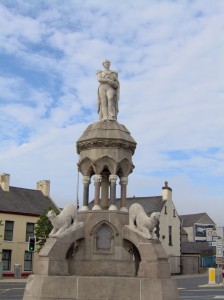
Crozier statue in Banbridge
On 11 June 1847, Sir John Franklin died from undetermined causes and Crozier assumed leadership of the beleaguered expedition. It was his first, and last, command in the Royal Navy. With stores dangerously low and no thaw imminent, Crozier decided to abandon the ice-locked ships and strike out for the Hudson’s Bay Company outpost on Great Slave Lake. Leaving Terror, his ‘home’ for so many years must have been a great wrench to Crozier, and not a decision taken lightly. If he could guide the crew to the Back’s River, some 250 miles to the south, it may be ice free, and afford them the opportunity to row the remaining 700 miles to Fort Resolution on Great Slave Lake. It was a desperate plan and evidence suggests that Crozier made careful and deliberate preparations.
Clothing was carefully adapted, screws were inserted in shoes to provide traction on the ice, and goggles were fashioned to prevent snow blindness. Remaining food supplies were removed from boxes and placed in sacks to reduce weight, and only minimal weapons were carried.
To navigate Back’s River, Crozier needed boats, plus enough equipment and food for the remaining 105 officers and crew, all of which would need to be lugged across the intervening inhospitable ice desert. This presented a daunting task for fit, strong men, never mind sailors who had been on half rations for the previous nine months and were generally in poor health. The twin spectres of frostbite and starvation loomed large.
Numbed with cold, dehydrated, and tortured by hunger, the survivors moved slowly, man-hauling their sleds and boats up jagged ice pressure ridges, while at other times sinking in soft wet snow up to their hips. Clothing, saturated by sweat while they hauled, clamped them like a frozen straightjacket when they rested. Physical punishment and torment were unrelenting as they advanced a pitiful three to four miles per day. While flesh on faces froze, turning the skin a scaly grey, it was frostbitten feet which caused most despair and panic. When these limbs became infected they swelled grotesquely, turned black, and emitted a foul smell. A man who couldn’t walk, couldn’t haul, and so became a liability and a burden to others.
In order to save the living, Crozier was forced to make a nauseating decision – to cannibalize the dead. Remains found along the route of this ‘death march’ attest to intentional dismemberment of corpses. Perhaps, in time, the debilitated and wretched survivors became accustomed to the taste of human flesh and bone marrow, and, in the ultimate act of desperation, may have been forced to kill some of their number for sustenance and survival. Substantial remnants of the expedition were eventually discovered near Montreal Island, some 60 miles short of the mouth of the Back’s River. Beyond this location no more remains, including the fate of the two ships, have (until recently) ever been found. The fact that the wretched men had been able to struggle so far was in itself a miracle and perhaps attests to Crozier’s inspired leadership. While all may have foundered, courage and camaraderie seemingly remained resolute in face of the most horrific Arctic conditions and deprivations.
Although it is possible that Crozier was devoured by polar bears, it has been suggested he may have survived to spend his remaining days amongst the nomadic Chippewyan Inuit of northern Canada. Certainly his previous forays into the Polar regions endowed him with the necessary knowledge and endurance skills to cope in the environment. Like these esquimaux herders, Crozier had been a polar wanderer for most of his life. Perhaps with them, he finally found contentment and acceptance for what he was, rather than discrimination based on his birth and social background.
In keeping with his renown as an explorer, the name Crozier is attributed to eight of the world’s landmarks including three Cape Croziers, a Crozier Channel, and a Crozier River. However, perhaps the most significant memorial to Francis Rawdon Moira Crozier lies about 240,000 miles away on the surface of the moon.
In naming ‘Crozier Crater’ in the lunar sea of Mare Fecunditais, the humble sea captain from Banbridge, is now rightfully recognised amongst the company of great polar explorers, including Amundsen, Shackleton, Scott, and Nansen who are also commemorated on the lunar landscape.
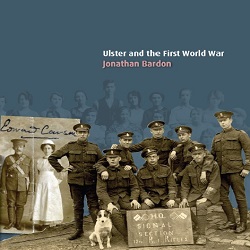 PRONI is pleased to invite you to a lunchtime lecture by renowned author and historian Jonathan Bardon OBE on Ulster and the First World War. This is to conincide with the launch of his new publication with the same title.
PRONI is pleased to invite you to a lunchtime lecture by renowned author and historian Jonathan Bardon OBE on Ulster and the First World War. This is to conincide with the launch of his new publication with the same title.



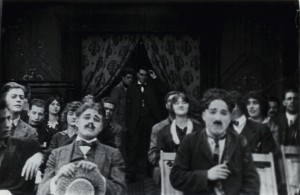 Other highlights include:
Other highlights include: 
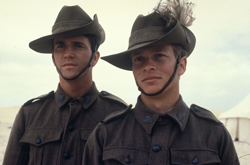 Other films in the programme include: the dazzling technicolor satire
Other films in the programme include: the dazzling technicolor satire 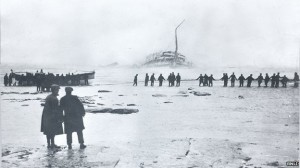
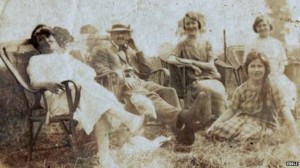
 The Inaugural Margaret McCoubrey Lecture
The Inaugural Margaret McCoubrey Lecture